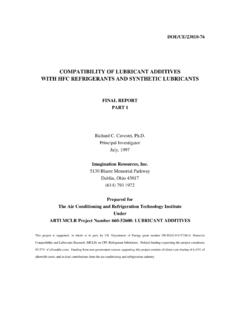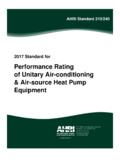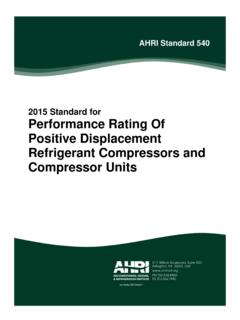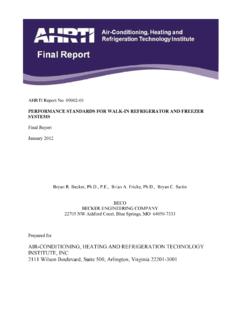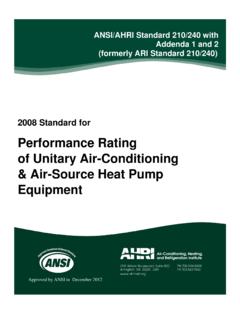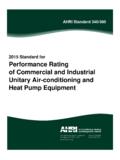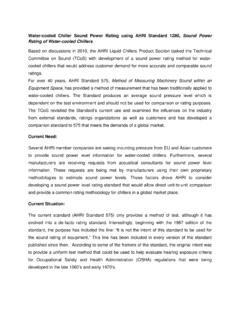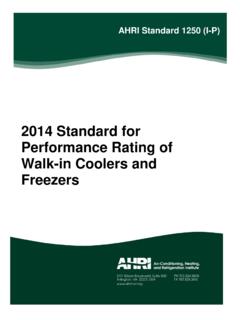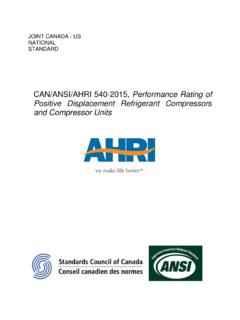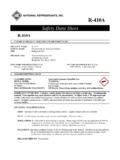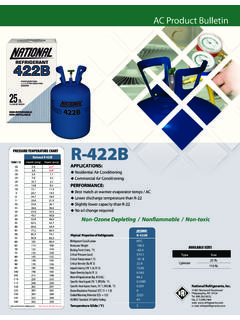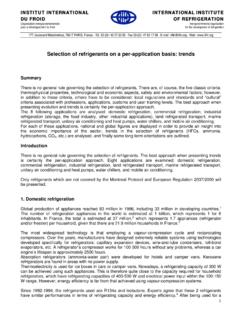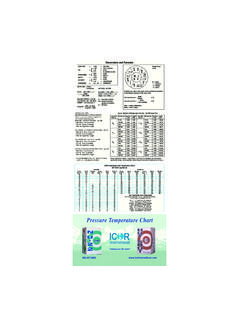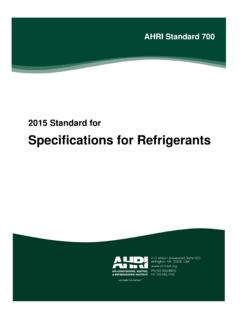Transcription of 2015 Guideline for Containers for Recovered Non- flammable ...
1 AHRI Guideline K. 2015 Guideline for Containers for Recovered Non- flammable fluorocarbon Refrigerants IMPORTANT. SAFETY DISCLAIMER. AHRI does not set safety standards and does not certify or guarantee the safety of any products, components or systems designed, tested, rated, installed or operated in accordance with this standard/ Guideline . It is strongly recommended that products be designed, constructed, assembled, installed and operated in accordance with nationally recognized safety standards and code requirements appropriate for products covered by this standard/ Guideline . AHRI uses its best efforts to develop standards/guidelines employing state-of-the-art and accepted industry practices. AHRI does not certify or guarantee that any tests conducted under its standards/guidelines will be non-hazardous or free from risk.
2 Note: This Guideline supersedes AHRI Guideline K-2009. Price $ (Members) $ (Non-Members) Copyright 2015, by Air-Conditioning, Heating and Refrigeration Institute Printed in U. Registered United States Patent and Trademark Office TABLE OF CONTENTS. SECTION PAGE. Section 1. 1. Section 2. Scope .. 1. Section 3. 1. Section 4. Containers ..2. Section 5. Responsibility of Owner .. 2. Section 6. Labels and Markings ..3. Section 7. Filling Procedures .. 4. Section 8. Transportation .. 5. APPENDICES. Appendix A. References - Normative .. 6. Appendix B. References - 6. Appendix C. Service Pressures for Selected Non- flammable fluorocarbon refrigerant Recovery Cylinders - Informative .. 7. TABLES FOR APPENDICES. Table C1. Service Pressures for Selected Non- flammable fluorocarbon refrigerant Recovery Cylinders.
3 7. AHRI Guideline K-2015. Containers FOR Recovered NON- flammable . fluorocarbon REFRIGERANTS. Section 1. Purpose Purpose. Recovery, recycling and Reclamation of certain non- flammable fluorocarbon refrigerants will prevent unnecessary release of these compounds. For practical and safety reasons, there is a need for Containers designed and identified specifically for these uses. This document is intended as a recommended guide of good practice to be used on a voluntary basis by all who supply, use, store or transport these Containers . In certain instances, this document sets forth federal requirements as of the date of publication hereof. This document is not intended to be an exhaustive listing of all such requirements. Applicable federal, state, and local requirements should be reviewed.
4 Intent. This Guideline is intended for the guidance of the industry, including manufacturers, engineers, installers, contractors, and users. Review and Amendment. This Guideline is subject to review and amendment as technology advances. Section 2. Scope Scope. This Guideline applies to cylinders with a maximum Service Pressure of 400 psig and ton tanks with a maximum Service Pressure of 500 psig for the receipt, storage and transportation of Recovered Non- flammable fluorocarbon Refrigerants. Where this Guideline mentions regulations that are mandated by the United States Federal Government, the reference to the Federal regulation is provided. Exclusions. This Guideline does not apply to American Society of Mechanical Engineers (ASME) pressure vessels for on-site recovery and storage that are not Department of Transportation (DOT) approved for transportation of non- flammable fluorocarbon refrigerants.
5 Section 3. Definitions All terms in this document shall follow the standard industry definitions in the current edition of ASHRAE Terminology website ( ) unless otherwise defined in this section. Reclamation. To reprocess refrigerant to new product specifications, by means which may include distillation. Chemical analysis of the refrigerant will be required to determine that appropriate product specifications are met. This term usually implies the use of processes or procedures available only at a reprocessing or manufacturing facility. Recovered Non- flammable fluorocarbon refrigerant . refrigerant that has been removed from a system for the purpose of storage, recycling, Reclamation or transportation. Service Pressure. The rated pressure marked on the cylinder or ton tank.
6 Special Permit Cylinder. A cylinder that has been by authorized by the DOT to be manufactured outside the scope of existing DOT regulations but in accordance with the requirements specified by DOT in a special permit. The requirements in the special permit may include design, composition, manufacture, testing, marking, and transportation criteria as well as special provisions. 1. AHRI Guideline K-2015. Section 4. Containers Cylinders for Recovered Non- flammable fluorocarbon Refrigerants as Referenced in Appendix C. Federal law requires that cylinders comply with United States DOT packaging requirements, in accordance with CFR Title 49, or as specified in an applicable Special Permit as provided by the cylinder manufacturer. Note: Federal law 49 5124 forbids the transportation of DOT Specification 39 (see CFR Title 49) non- reusable/non-refillable cylinders, if refilled.
7 Non-refillable cylinders meeting DOT Specification 39 should not be refilled or reused for any reason due to risk of serious personal injury. Valve outlet connections should comply with Compressed Gas Association Publication V-1. Pressure relief devices are required to comply with Compressed Gas Association Publication Valves used for vapor and/or liquid withdrawal should be clearly identified and marked. Ton Tanks for Recovered Non- flammable fluorocarbon Refrigerants as Referenced in Appendix C. Federal law requires that ton tanks comply with United States DOT specification 106A500X or 110A500W. as detailed in 49 CFR Part 179, Subpart E. Valve outlet connections should comply with Compressed Gas Association Publication V-1. Federal law, CFR Title 49, requires that pressure relief devices comply with CGA Publication Containers for Recovered Non- flammable fluorocarbon Refrigerants R-11, R-113, and R-123.
8 DOT Specifications require that steel drums comply with UN Specification 1A1, as per 49 CFR Part 178, Subpart L. Containers that originally contained new refrigerant R-11, R-113, or R-123 (excluding those originally used for cleaning agents) may be used, provided the following conditions are met: The drums should be inspected internally and externally and found to be clean and free of dents, bulges, holes, cracks, rust, pits, creases or other structural weaknesses. Closure devices, including gaskets, should be in such condition that they comply, in all respects, with the original requirements for the drum. Drums that originally contained refrigerant R-11, R-113, or R-123 should be made to comply with Section Previous labels and markings should be removed and be replaced with new labels and markings per Section Section 5.
9 Responsibility of Owner This section applies only to cylinders and ton tanks, not drums, because drums are not compressed gas Containers . See applicable definitions in 49 CFR Part 171, Subpart A. Cylinder Filling. Only the owner may fill his/her Containers or grant permission for some other party to fill them. Responsibility to assure that the service pressure rating of the cylinder or ton tank is appropriate for the material being Recovered rests with the filler. Different refrigerants require different minimum Service Pressures, as per Appendix C. 2. AHRI Guideline K-2015. Cylinder/Ton Tank Retesting. Federal law requires that refillable cylinders used to recover refrigerant must be inspected and hydrostatically tested a minimum of once every five years in accordance with 49 CFR Part 180, Subpart C or as specified in an applicable Special Permit as provided by the manufacturer of the cylinder.
10 Testing by visual inspection alone is not permitted (See 49 CFR Part 180, Subpart C). Responsibility to assure the cylinder or ton tank is within the test date rests with the filler even if the filler is not the owner of the container. Per 49 CFR Part 180, Subpart C, no cylinder is permitted to be filled with a hazardous material and offered for transportation in commerce unless that cylinder has been successfully requalified and marked in accordance with DOT. requirements. Per 49 CFR Part 180, Subpart F no ton tank is permitted to be filled with a hazardous material and offered for transportation in commerce unless that ton tank has been successfully requalified and marked in accordance with DOT. requirements. Section 6. Labels and Markings DOT Requirements.
